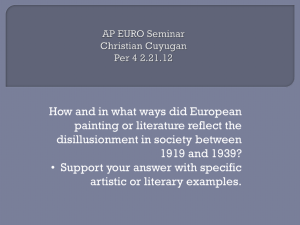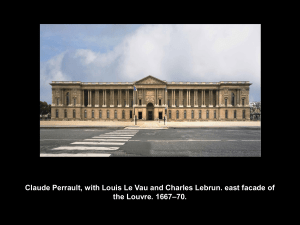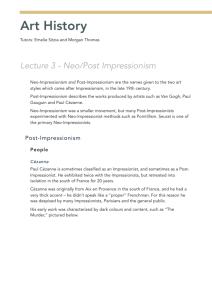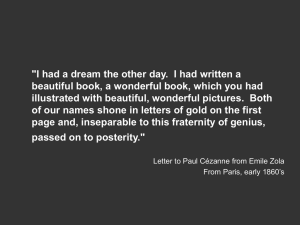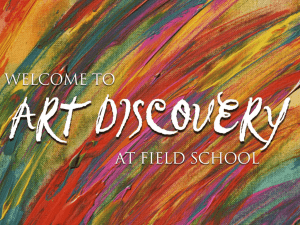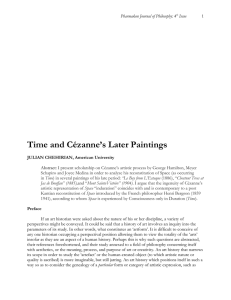CoryART331MidtermSG
advertisement
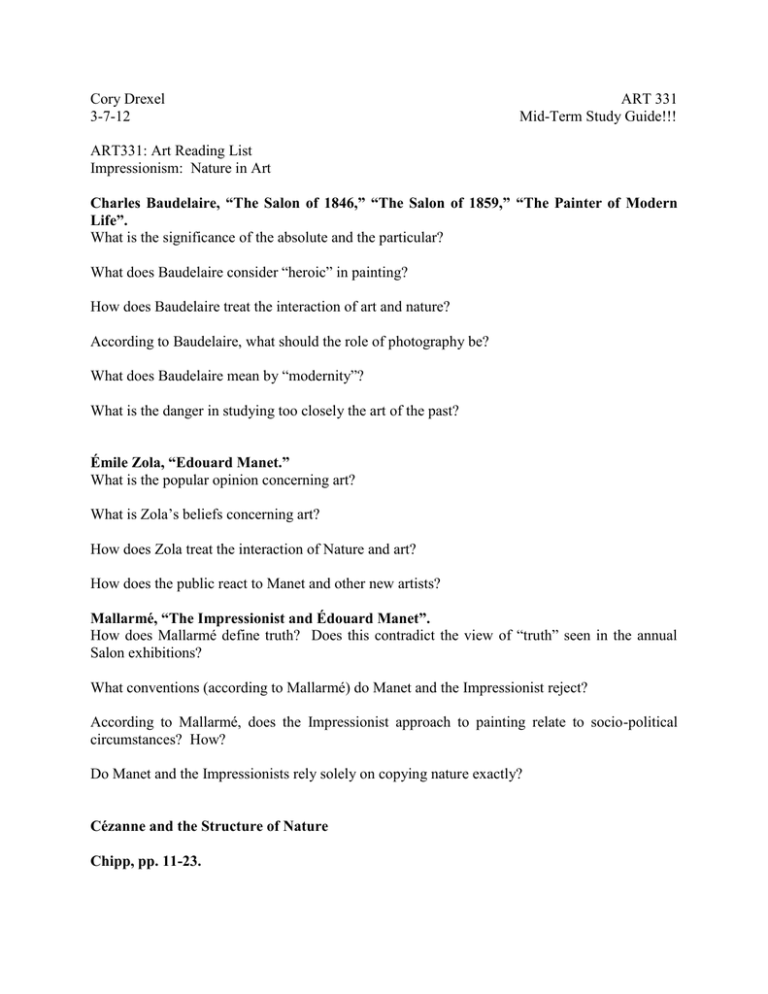
Cory Drexel 3-7-12 ART 331 Mid-Term Study Guide!!! ART331: Art Reading List Impressionism: Nature in Art Charles Baudelaire, “The Salon of 1846,” “The Salon of 1859,” “The Painter of Modern Life”. What is the significance of the absolute and the particular? What does Baudelaire consider “heroic” in painting? How does Baudelaire treat the interaction of art and nature? According to Baudelaire, what should the role of photography be? What does Baudelaire mean by “modernity”? What is the danger in studying too closely the art of the past? Émile Zola, “Edouard Manet.” What is the popular opinion concerning art? What is Zola’s beliefs concerning art? How does Zola treat the interaction of Nature and art? How does the public react to Manet and other new artists? Mallarmé, “The Impressionist and Édouard Manet”. How does Mallarmé define truth? Does this contradict the view of “truth” seen in the annual Salon exhibitions? What conventions (according to Mallarmé) do Manet and the Impressionist reject? According to Mallarmé, does the Impressionist approach to painting relate to socio-political circumstances? How? Do Manet and the Impressionists rely solely on copying nature exactly? Cézanne and the Structure of Nature Chipp, pp. 11-23. How did Cézanne conceive of nature? How did he see nature? How does this differ from the Impressionists? Define the artistic term concrete, in relation to Cézanne’s words. Why were the Venetians (Titian, Veronese) and the Spaniards (Velazquez) the best painters? Why, if he was moving towards abstraction, did he consider it important to paint out-of-doors? What did Cézanne think of art theory? Denis, Maurice, “Cézanne”. (Reader) When Cézanne died in 1906, how did the press describe his significance? How does Denis differentiate between Manet, Gauguin and Cézanne? What did Cézanne do with Impressionism? What are some of the ways Denis describes Cézanne’s painting? What does Denis mean when he characterizes Cézanne as a classic? Bell, Clive, “The Debt to Cézanne”. (Reader) Bell writes the following: “Cézanne certainly marks the beginning of a movement, the main characteristics of which it will be my business to describe.” What are these main characteristics? Bell argues for the strict separation between aesthetic and representational value in art. Why? Fry, Roger. “The French Post-Impressionists”. How does Fry defend the accusation of the Post-Impressionists lacking skill? What are the aims of the Post-Impressionist artists if not representation? Who, according to Fry, was the first to approach the simplification to the essential (in form)? What is the difference between “Classical” and “Romantic” art? Which are the PostImpressionists? Clive Bell, “Simplification and Design” (1914). What does Bell mean by “significant form”? Bell states that the only important distinction is between good and bad. Do you agree? How does Cézanne reflect Bell’s ideas? Favorably? What is Bell’s view on representation in art? Bell, Clive, “The Aesthetic Hypothesis.” (Reader) How useful is the study of aesthetics, according to Bell? What does he say about Frith’s Paddington Station? What type of emotion is provoked by painting? Describe. What is the one quality common to the visual arts? How does he feel about representational art? What do we need to appreciate art? Fry, Roger, “An Essay in Aesthetics”. What is the purpose of the essay, according to Fry? How does Fry characterize Cézanne in relation to Modernism? What was the role of nature for Cézanne? How does Fry describe the Romantics? The Realists? What is the justification of art, according to Fry? Compare this essay to Clive Bell. Is nature important? ART331: Art Reading List Vincent Van Gogh Chipp, pp. 29-47. How does Van Gogh’s approach to art (its impetus, its purpose) differ from Cézanne’s? How does Van Gogh’s conception of nature, and of representing nature differ from both Cézanne’s and the Impressionists’? Does he manipulate nature? Observe is as objectively? What role does imagination play in the art of Van Gogh? Painting from nature? Painting form memory? How does Van Gogh formulate color? Purely from nature? Who were Van Gogh’s artistic inspirations? In Van Gogh’s paintings, especially the later ones, doe s he paint what he sees from nature, or does he make iconographic metaphoric choices? Denis, Maurice, “From Gauguin to Van Gogh to Classicism” How were the artists Denis describes (the Post-Impressionists) different from the Impressionists? How did Denis describe his art, and that of his contemporaries in response to nature? How does Denis characterize the work of Van Gogh? Cézanne? Gauguin? Paul Gauguin’s Synthetist Theories Chipp: pp. 48-66, 83, 105. Define synthetism in relation to Gauguin What was Gauguin’s view of the Master’s, say Raphael? Is Gauguin the first to suggest the power of Symbolism/Synthetism? First to practice either knowingly or intuitively? What role does nature play in the art of Gauguin? Describe his view of the writers aims, and literature more generally. Do you agree? What is primitivism? How do you define it? How is it customarily defined? How does Maurice Denis define “synthetism?” How does this differ from a stylization of a subject? Symbolism and the Primacy of Individual Vision. Chipp, p. 87-114. What is the role of the art/or artist according to Aurier? What is the difference between idealistic and ideistic? What does an artist need to posses according to Aurier? According to Denis, what is art? The main gist? How does Denis define nature? What, according to the synthetists, accounts for the emotivity in art? Were all the symbolists affiliated with a group? How does Edvard Munch define nature? ART331: Art Reading List / SP05 Paul Gauguin and Synthetist Theories 1. What is the role of the art/or artist according to Aurier? 2. What is the difference between idealistic and ideistic? 3. What does an artist need to posses according to Aurier? 4. According to Denis, what is art? The main gist? 5. How does Denis define nature? 6. What, according to the synthetists, accounts for the emotivity in art? 7. Were all the symbolists affiliated with a group? 8. How does Edvard Munch define nature? Chipp: pp. 124-28, and 130-43. 1. How did Matisse and Gauguin differ in their views of artistic expression? 2. What role does color play in his work? 3. What does Matisse mean by likening art to a good armchair? 4. Does Matisse work from nature? 5. How does Matisse describe the importance, or lack thereof, of artistic training (i.e. preparation)? 6. What does Matisse mean when he says, “Exactitude is not truth?” Worringer, “Abstraction and Empathy” (1963). What (generally) is the “theory of empathy”? What lies at the opposite pole of empathy? What is the main point of his investigation? “The foil for the ensuing treatise?” What accounts for the urge to abstraction as discussed by Worringer? How does abstraction, according to Worringer, relate to a culture state? Hermann Bahr, “Expressionism” (1920). What do all of the newest schools in painting have in common? How do the “beholder” and the Expressionist differ in their conception of art? How does Bahr characterize the act of seeing? How is the Expressionist like primitive or primeval man? How does Expressionist art relate to the world, world events, and specifically WWI? How does one explain the ”ugliness” found in Expressionist art? Art 331: Art Reading List Expressionism and Conflict: Die Brücke and Der Blaue Reiter CHIPP: Emile Nolde, from Jähre der Kampfe (1902-14). How did the Die Brücke artists describe primitivism? How does Emil Nolde approach nature? What role does religion play? Could some people consider Nolde’s work blasphemous? Ernst Ludwig Kirchner, “Chonik der Brücke” (1916). (Pg. 174) Describe the goals of the Die Brücke artists in regard to their art. What the importance of non-Western models? Wassily Kandinsky: On Problem of Form, 1912 What is the link between matter and the creative spirit? What is the new value? To Kandinksy, how does form reflect the personal? What are the three elements that “leave their stamp on a work of art”? Explain. Describe the significance, according to Kandinsky, of inner necessity? How does Kandinsky describe the current practice in art of creating forms abstract or realist? Do you agree with the way he describes the realist endeavor on page 161? What does Kandinsky mean by the practical purposeful element? How should a viewer approach a work of art? Kokoschka, “On the Nature of Vision”, 1912 Describe Kokoschka’s “vision”. Marc, “How does a Horse See the World ”and “Aphorisms”. What is an aphorism? Which one do you find the most true? Why? From his 1915 Letter: Why animals? Klee, “Creative Credo,” 1920 Describe Klee’s view on the process of creation. READER: Cheney, Sheldon. “Abstraction and Mysticism” (1943) According to Cheney, what are the three aspects of form that leads to great art? What other art form is abstract? What type of an artist must the modern abstract artist be, according to Cheney? What is the Expressionists aim in producing a plastic (formal) synthesis? How does Cheney perceive of the mystic? What does he feel is more important? Intellect or spirit? E. H. Gombrich, “Expression and Communication,” (1971). What are the two uses of art (the two extremes)? Is there such a thing as a natural response to form or color? What did C.E. Osgood hypothesize on in relation to art, and how did he support it with a chart? Do forms or colors naturally express emotions (sad, happy), or does the context determine their expression? What does Gombrich mean by mutual modification?
